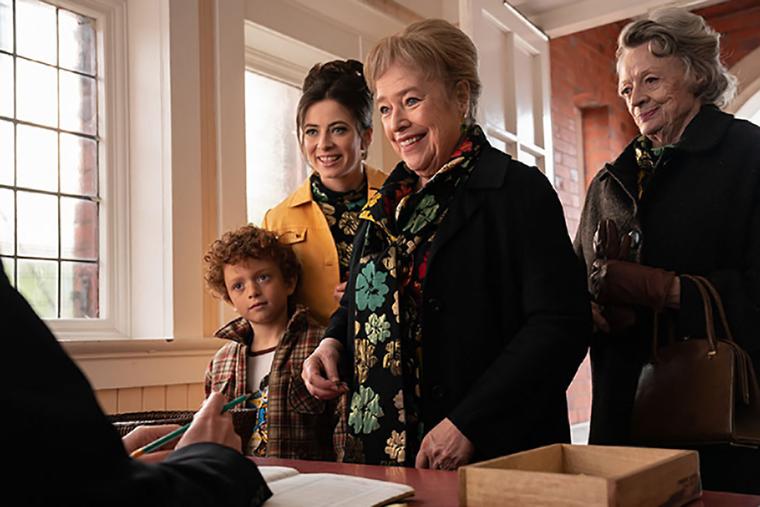‘The Miracle Club’ Speaks of Pain, Hope, Forgiveness — and Lourdes
This new movie is a story about Lourdes and the miracles that happen there

In “The Miracle Club,” three women from the working-class Irish town of Ballygar and a visitor from the U.S., with a little help from their parish priest Father Dermot Byrne, embark on a trip to Lourdes. It’s an exciting moment: It’s the first time any of them has visited the French city, and each has a dream that God will grant them a miracle and change something in their lives.
- Lily, played by the indomitable Oscar-winning Dame Maggie Smith, hopes for forgiveness after she intervened in her deceased son’s life.
- Eileen (Kathy Bates) hopes for the healing of a potentially cancerous lump in her breast.
- Dolly, the younger woman played by Agnes O’Casey, wishes that her autistic son Daniel could speak.
- And Chrissy (Laura Linney), who has just arrived from America to attend her mother’s funeral, seems in need of a kind of reconciliation with her departed mother and with the women of the town.
In the end, each woman does experience a miracle — but it’s not the sort of thing each was expecting. But as Father Byrne said to Eileen, “You don’t come to Lourdes for a miracle, Eileen. You come for the strength to go on when there is no miracle.”
The Register talked with the film’s director, Thaddeus O’Sullivan, and with actress Laura Linney about their perceptions of miracles, both in the film and at Lourdes. O’Sullivan talked about the characters’ mistaken expectations: “They all have feelings of guilt for one reason or another,” said O’Sullivan.
Young Dolly is asking for some answer to her problem, because she thinks she may have harmed her autistic child when he was in the womb. Eileen, Kathy Bates’ character, has hated the Laura Linney character since, pregnant and unmarried, she left her ancestral home for the U.S. That hate has eaten away at her all these years; and to confront that at the last minute, on the bus on the way back, is what Lourdes was about for her. It’s a difficult thing to admit, ‘I hated you’; but she’s finally able to put words to the emotions which have been eating away at her.
Laura Linney thought that each of the characters saw something happen in her personal life, but more than that, they all got along with one another and they restored their relationships. As for the character she played, Chrissy, Linney recollected:
The puzzle that was her life, that never fit together — well, it suddenly made sense. There were secrets that had been kept for years; so for her, being given the truth about who she was, where she came from — that is the miracle of honesty.
Linney and O’Sullivan seemed to have a rather pragmatic view of Lourdes and the miracles that have occurred there. “I felt very comfortable making this film,” said O’Sullivan,
... very comfortable with these characters. It might have been an angrier film if I’d made it 15 or 20 years ago, when I was first approached. ... I suppose that my experience of religion was very particular, but I’ve gotten all of that out of my system. And I suppose I’m much less judgmental. When you’re trying to make a film with issues like this, you don’t want to be judgmental — because it’s not about you, it’s about them!
Laura Linney admired her character, noting that Chrissy showed a good deal of restraint in dealing with the other women.
“She’s done a lot of work on herself!” Laura noted. “I hope that it makes people consider the evolution of women in society, and how our roles have changed, how the information we are given has become a little more honest. ... And there’s a more honest conversation today about the role of religion in your life.”
Linney was disappointed that the was not actually filmed in Lourdes.
“I would love to have gone there,” she said, “but then, the Catholic Church is famous for not allowing filmmaking to go on in any area of the Catholic faith. I’m sure we would never have been permitted to film there.”
Did she believe that what happened there at Lourdes was true? Not Catholic herself, she acknowledged that there have been healings, but not in large numbers. “I think,” Laura said, “it’s a number under 100. I think that information can make people feel disappointed.”
It was an important point — and not one with which I wanted to end my research. So I looked it up, and in one sense, Linney was right: There have been only 70 confirmed miracles at Lourdes since 1858, when the Blessed Virgin Mary appeared 18 times to young Bernadette Soubirous. However, the total number of reported miracles is over 7,000 — over 100 times as many as the confirmed, or “approved” miracles. The Catholic Church has always been cautious in researching and confirming a miracle before the story is formally approved. In some cases, there may be insufficient witnesses to verify the healing or other miracle; in other cases, the research may be ongoing for years before a final announcement is made.
In any case, we are grateful for those miracles that have been confirmed, because they testify to the truth of Mary’s loving care.
“The Miracle Club” opens in theaters nationwide on July 14.
- Keywords:
- movies
- the miracle club
- lourdes
- our lady of lourdes
- miracles

















